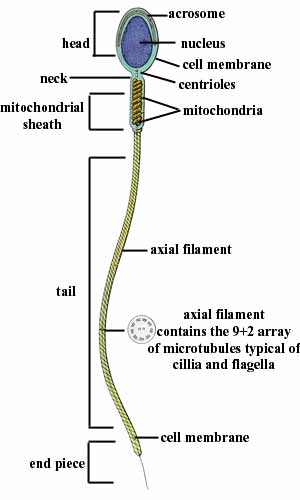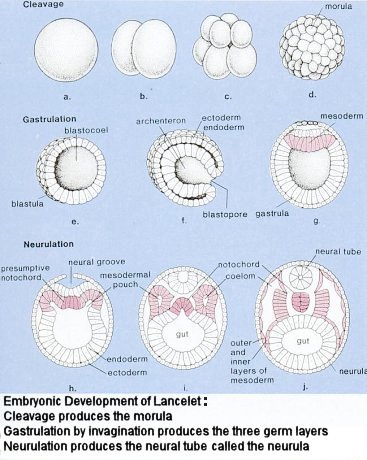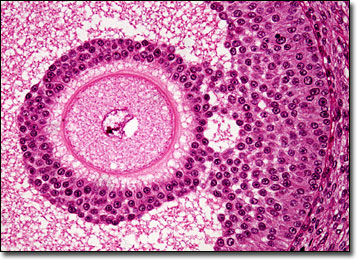The egg cell is released into the oviduct, or fallopian tube, and cilia lining the fallopian tube convey the egg cell down to the uterus. The inner lining of the uterus is called the endometrium.
At the base of the uterus is cervix, which leads to the vagina, the canal through which a baby is born.
 Spermatogenesis is the production of mature sperm cells, and it occurs in the seminiferous tubules. The cells that give rise to sperm are called spermatogonia. They undergo meiosis and differentiation eventually to form mature, motile sperm.
Spermatogenesis is the production of mature sperm cells, and it occurs in the seminiferous tubules. The cells that give rise to sperm are called spermatogonia. They undergo meiosis and differentiation eventually to form mature, motile sperm.The head of the sperm is tipped with an acrosome, which secretes enzymes that help the sperm penetrate the egg.

 Oogenesis is the development of mature ova. Oogonia are the cells that develop into ova; they multiply and begin meiosis, but they stop at prophase I of meiosis I. These egg cells are called primary oocytes, which are quiescent until puberty. From puberty onward, FSH periodically stimulates a follicle to grow and its egg cell to complete meiosis I and begin meiosis II. This forms the secondary oocyte.
Oogenesis is the development of mature ova. Oogonia are the cells that develop into ova; they multiply and begin meiosis, but they stop at prophase I of meiosis I. These egg cells are called primary oocytes, which are quiescent until puberty. From puberty onward, FSH periodically stimulates a follicle to grow and its egg cell to complete meiosis I and begin meiosis II. This forms the secondary oocyte.At birth, a female’s ovaries contain about 1 million follicles, each with an ovum that has begun meiosis but is arrested in Prophase I of the first meiotic division.
At this stage, the ova are called primary ooctes. Some of these primary oocyte-containing follicles are stimulated to develop during each cycle.
 During each follicular phase several follicles are stimulated to grow under FSH stimulation, but only be achieves full maturity as a tertiary, or Graafian, follicle by ovulation.
During each follicular phase several follicles are stimulated to grow under FSH stimulation, but only be achieves full maturity as a tertiary, or Graafian, follicle by ovulation.The primary oocyte completes the meiotic division during the follicular phase. Instead of forming two equally large daughter cells, however, it produces one large daughter cell, the secondary oocyte, and one tiny daughter cell, called a polar body.
Thus the secondary oocyte acquires almost all of the cytoplasm from the primary oocyte (unequal cytokinesis), increasing its chances of sustaining the early embryo should the oocyte be fertilized.
The polar body disintegrates and the secondary oocyte then begins the second meiotic division, but its progress is arrested at Metaphase II. It is in this form that the egg cell is discharged from the ovary at ovulation, and it does not complete the second meiotic division unless it becomes fertilized in the fallopian tube.
Humans and other primates have menstrual cycles, and other mammals have estrous cycles. Menstruation occurs when the endometrium is shed from the uterus through the cervix and vagina.

The menstruation flow phase of the female cycle is the phase during which menstruation bleeding occurs.
The proliferative phase of the menstrual cycle is that during which the endometrium begins to regenerate and thicken.
In secretory phase, the endometrium continues to thicken, and is the embryo has not implanted in the lining by the end of this phase, menstruation flow occurs.
The ovarian cycle parallels the menstrual flow cycle, and begins with the follicular phase, in which several follicles begin to grow.
At the end of the follicular phase, ovulation occurs, during which the secondary oocycte is released from the ovary.
During the luteal phase of the ovarian cycle, endocrine walls in the corpus luteum secrete hormones.
Pregnancy (gestation) is the condition of carrying at least one embryo.
Start of 47 Animal Development

Animal Development: The stages of early embryonic development
After fertilization, there are three successive stages in early development
1. Cleavage which is a period of rapid mitotic cell division, partitions the cytoplasm of the zygote into smaller cells called blastomeres each which has its own nucleus.
Continued cleavage leads to a ball of cells called a morula, and then a fluid-filed central cavity called the blastocoel forms within the morula to produce a blastula.
2. Gastrulation is a drastic rearrangement of the cells in the blastula. In gastrulation, three (germ) cell layers are produced—ectoderm (later forms the nervous system and outer layer of skin). The endoderm (later develops to line the digestive tract). The mesoderm (later develops into most organs and tissues).
Multiple Choice Questions:
1. Storage and maturation of human sperm occur in the
A. Epididymis
B. interstitial cells
C. seminiferous tubules
D. sertoli cells
E. vas deferons
2. The function of the acrosome in the sperm head is to
A. provide ATP for flagellar movements
B. control DNA replication in the sperm
C. store enzymes used for penetrating the egg during fertilization
D. enclose the genetic material
E. provide a sharp head of the sperm to penetrate the egg
3. The dorsal lip of the blastopore induces development of the
A. trophoblast
B. mesoderm germ layer
C. mouth in deuterostomes
D. coelom
E. notochord
Answers: 1. A, 2. C , 3. E


No comments:
Post a Comment